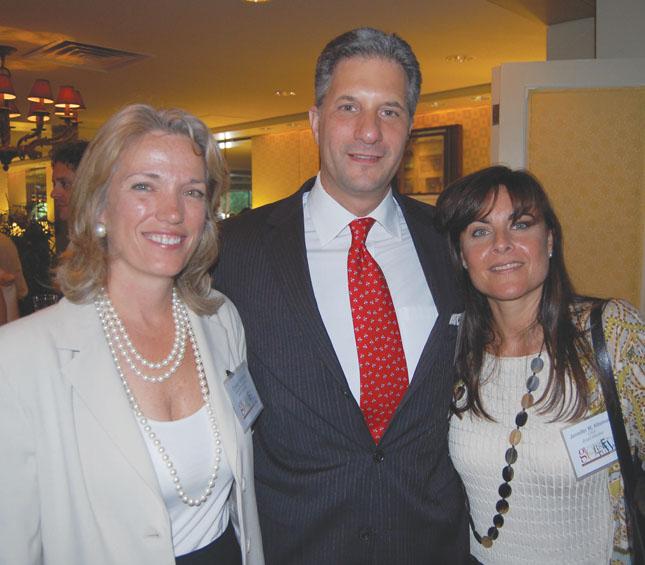BID Delivers Awards, Good News at Annual Meeting
By • June 18, 2013 0 1647

The Georgetown BID celebrated another year of representing the village’s business interests at the BID Annual Meeting on June 10, held at the Four Seasons Hotel. Neighbors and business owners alike came out to mingle, tip a few back and hear the BID’s take on a business market often subjected to a fair share of doomsaying.
There you would have never guessed it. The buffet spread was impressive, laughter reverberated around the room and a few celebrities even popped in at the gathering’s fringes (reports circulated that Laura Bush stopped by to say hello). In one corner, BID marketing staffers Debbie Young and Nancy Miyahara presided over a cut-and-paste project where participants could cut pictures from magazines and affix them to one of several sheets of butcher paper labeled with a specific neighborhood-centric theme, such as “My Hopes for Georgetown,” “Shopping in Georgetown,” and “Georgetown Makes me Feel…”
Some guests turned their nose at the project, others gutted entire periodicals to get their ideas down on paper, so to speak. In the end, the activity highlighted the theme of the evening: that a successful Georgetown will rely on a vast collection of images and ideas to form a single identity as a commerce center that can draw business from visitors and Washington natives alike. The BID calls it their “brand review,” and earlier this year hired The Roan Group, a local consulting firm, to help articulate Georgetown’s “brand” and derive an edge from it. The firm’s principal Neill Roan gave a presentation on his company’s findings that evening, and BID board President Crystal Sullivan delivered an upbeat speech on the neighborhood’s business prospects.
“[The BID looks] forward to 2010 with anticipation and also optimism,” she said.
So far, BID’s sanguine outlook appears to be dead on. Sullivan was excited to announce that at long last the blue bus, often thought of as the runt of the bus routes traversing through Georgetown, would be assimilated into the enormously popular Circulator system beginning Sept. 1, 2010. The new Circulator route, which extends through Georgetown between Rosslyn station and Dupont Circle, will mirror its predecessor, which has for a decade ferried riders in and out of the mass transit-challenged Georgetown, despite recurring funding lapses that nearly axed the program on several occasions.
The numbers also looked good for BID-sponsored community events, which in the past year have grown enormously in both popularity and controversy (the exorbitant budget for the Merriment Christmas celebration ignited particular ire among board members last summer). Nevertheless, public attendance has been on the rise, with a record 12,000 attendees and 30 restaurants participating in the October 2009 Taste of Georgetown event. The April 2010 French Market also enjoyed record attendance, and charitable donations collected for the Georgetown Ministry Center through BID-sponsored events increased 10 percent over last year. In September, Sullivan said, the BID plans to organize a Georgetown chapter of Fashion’s Night Out, Vogue magazine’s international fashion gala for charity. At present, Georgetown plans to be the only District neighborhood involved with the project.
Finally, the BID’s finances were reported to be in healthy shape. Board Vice President Andrew Blair said the organization had budgeted a revenue increase of over a quarter million dollars in 2010 (totaling $4.8 million), while anticipating an increase in program expenses to $4.4 million, nearly equaling the total revenue figure from 2009.
Afterward, Neill Roan took the stage and delivered a slideshow presentation on the brand identity of Georgetown, based on data and interviews gathered from local businesses and residents. In his presentation, big on aphorism but hazier on more practical conclusions, Roan called the Georgetown cachet “an identity driven by perception, myth … and experience,” citing its stature as a unique historical district seldom matched nationwide in both historical preservation and proximity to a major city. The direct benefits of this identity, however, remained unclear.
Roan did have a few more concrete responses to typical complaints about the neighborhood, notably its scarcity of on-street parking and inaccessibility for mass transit passengers. He also questioned the usefulness of Georgetown’s liquor moratorium, an ordinance he called “a barrier to new restaurant development.”
- BID board President Crystal Sullivan, GBA President Joe Giannino, CAG President Jennifer Altemus | Robert Devaney




